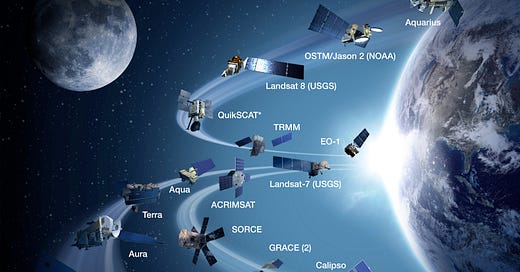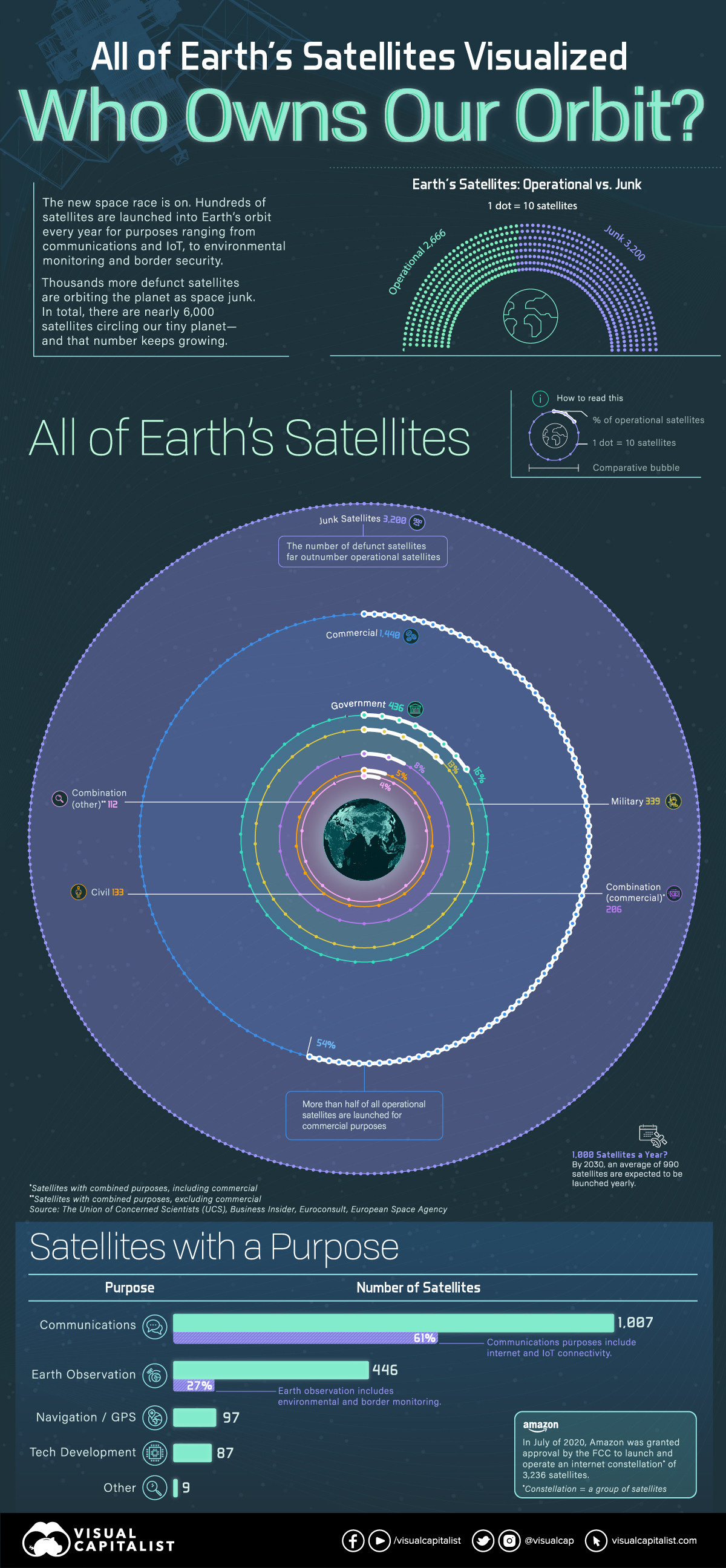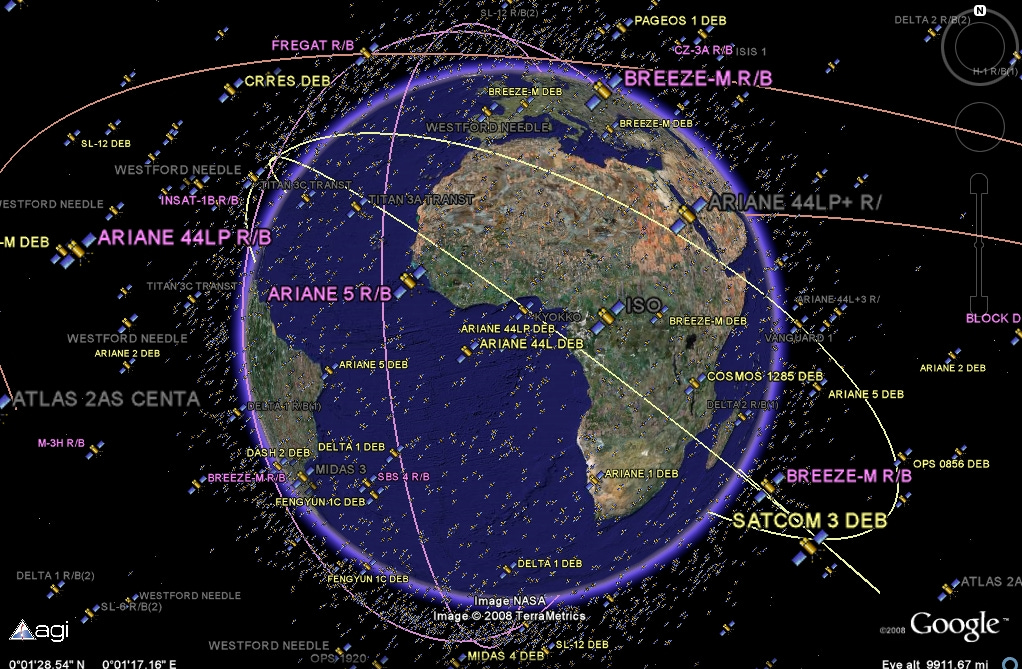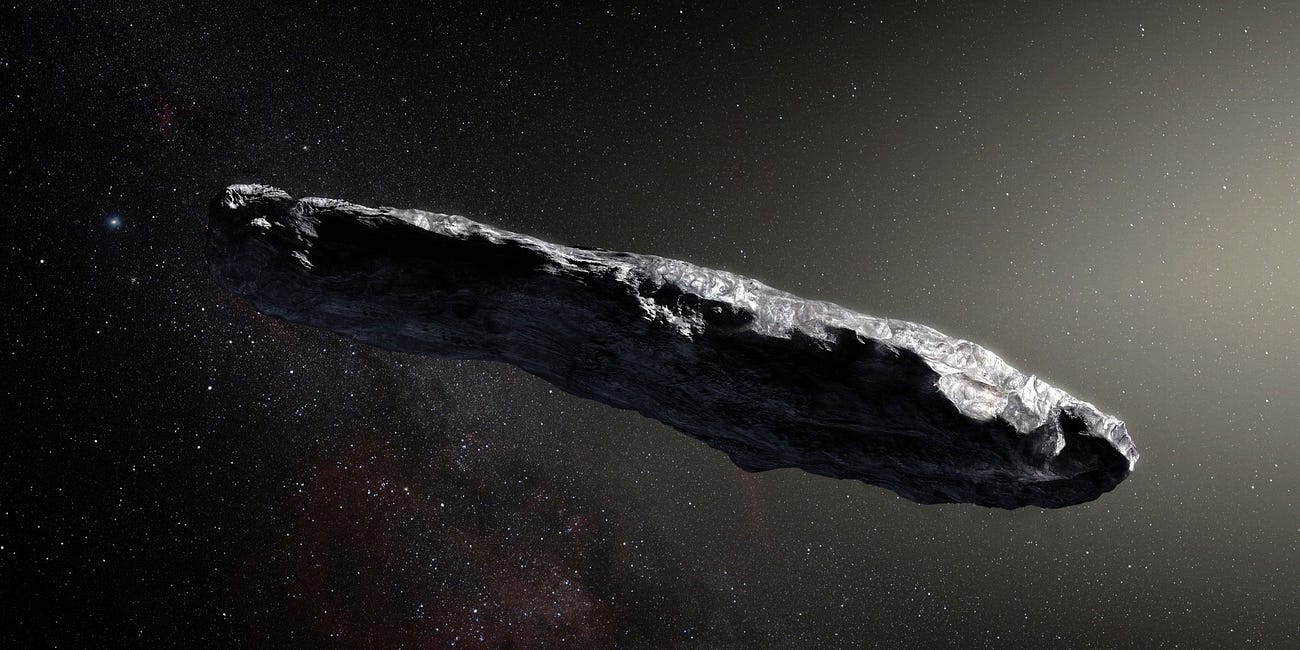Diagnosis: Kessler Syndrome
Our Earth Orbiting Asteroid Belt is a Profit-Driven, Budding Environmental Disaster
The progress of human utilization of Earth’s orbital space has rapidly accelerated since the first moon landing in 1969. Thousands of satellites have been launched to facilitate the Global Positioning System (GPS), communication, weather observation and modelling, disaster response, and a variety of other beneficial uses.
As of April 2020, there were roughly 6,000 satellites circling the globe, with just 2,666 of them still operational. Of those, a bit more than half serve commercial purposes, from communication to tv and internet connectivity, Earth observation, environmental monitoring, and border security. (Some satellites serve multiple purposes).
Around 29% of all satellites exclusively serve government or military. SpaceX currently owns the largest share of satellites of any private entity at 22%. Euroconsult, a satellite strategy and consulting firm, predicts that about 1,700 satellites per year will be launched by 2030. The question is, does this portend disaster? Is this yet another sector of existence humans will irreversibly pollute for commercial purposes?
Source: World Economic Forum
While outer space is big, really big, the area of extraterrestrial commercialization is far less so. Let’s get a handle on the overall playground of satellites.
There are three types of orbits Earth-targeting satellites use: High, Medium, and Low Earth Orbit. I will reference them mostly by just ‘high’, ‘medium’ and ‘low’. Note that a single orbit’s distance from Earth can vary widely over its trajectory. The Molniya Orbit, for example, is a geosynchronous orbit, meaning the satellite always stays over the same location on Earth. To do so, it follows an elliptical orbit, which can alter its distance from the surface by thousands of miles at different stages.
High orbits occur when a satellite reaches about 22,369 miles (36,000 km) above the surface. At this distance, satellites inevitably match the Earth’s rotation and thus become sort of de facto geosynchronous satellites. Except at the equator, satellites at this range tend to drift slightly north or south, but remain in a relatively fixed position. Missions at this distance focus on weather monitoring—such as the Geostationary Operational Environmental Satellite (GOES)—mapping, communication, television broadcasting, and monitoring aviation.
A few satellites are positioned even higher at places called the Lagrange points. Here, maintaining orbital stability is a precise process as the gravity differential between the Earth and Sun is equalized. A slight disturbance can easily upset the satellite’s orbit. Missions here include the Solar and Heliospheric Observatory (SOHO), the James Webb Space Telescope (JWST), the Wilkinson Microwave Anisotropy Probe (WMAP), and others. These tools study the sun, solar system, and cosmos.
Medium orbit objects follow semi-synchronous or Molniya orbits. Semi-synchronous orbits have slight to notable eccentricity (think of a squished circle), and are placed about 1,255 miles (20,200 km) or more above the surface. Objects in Molniya orbits are particularly suited to observing the higher latitudes (meaning the Antarctic region) and follow a highly eccentric path as depicted here. Their position allows them to enable communications at the most extreme ends of the Earth’s poles.
Source: NASA Earth Observatory
Low Earth Orbit is the area in which most satellites traverse, especially commercial, scientific, and regional weather satellites. Low is “an orbit around the Earth with an altitude that lies towards the lower end of the range of possible orbits.” This means satellites orbit at a distance of around 1,200 miles or less from Earth’s surface, or slightly less than the distance from New York City to Dallas, or Cairo to Rome.
Satellites travelling in this orbital range must maintain a speed of around 17,500 mph or 7.8 km/s to resist the pull of Earth’s gravity. That’s about 20x faster than the speed of a 9mm bullet fired from a gun. The speed varies somewhat depending upon the actual altitude of the satellite, but regardless, it is fast.
A satellite’s inclination determines its position relative to the area it observes. The Tropical Rainfall Measuring Mission (TRMM), for instance, had an inclination of 35° to keep it near the equator because its purpose was to collect information on rainfall and heat in the tropics. Many low orbit vessels follow a nearly circular orbit and specified inclination, revolving around the area pertinent to their mission. Scientific and communication satellites, especially, tend to follow geosynchronous orbits to stay in their “sweet spot.”
Geosynchronous orbits match the Earth’s rotation, which keeps the satellites positioned over a stationary spot or area on the surface. This means they are still moving, and at high speeds, but just-so to match the movement of the Earth.
The issue of concern is the destruction of Low Earth Orbit space, as that comprises the area with the heaviest traffic, and is the most sought-after space. Nearly all satellites in this range consist of sizes comparable to an average school bus or smaller (the main exception here of course is the International Space Station [ISS]). Including both the active and defunct, that encompasses around 6,000 vessels.
In addition to those, Dr. Laura Grego, senior scientist with the Global Security program of the Union of Concerned Scientists (UCS), notes that there are tens of thousands of pieces of space debris that UCS tracks in low orbit; NASA estimates that there are about 500,000 pieces of space junk of marble size or larger, and about 100 million pieces larger than 1mm. These consist of tiny to moderate-sized debris fragments, larger parts—such as mechanical arms or boosters—and fully articulated, defunct satellites.
Debris of all sizes is extraordinarily dangerous. Single flecks of paint moving at low-orbit speed have severely damaged windows on the space shuttle. Sometimes, even debris floating around for a decade finally finds it mark, as occurred in 1996 when a French satellite took considerable damage from such an object.
Destruction of an entire satellite, such as what happened in 2007, when China used a missile to destroy a defunct weather satellite, distributed more than 3,500 pieces of large, trackable debris and tens or even hundreds of thousands of smaller pieces. Russia destroyed one of its own in 2021, causing panic on the International Space Station. Millions upon millions of pieces of varying sized junk travelling at speeds well in excess of fired bullets create a terrifyingly dangerous environment.
No one entity conducts “air traffic control” of space; satellites just whizz around somewhat willy-nilly. Moreover, these objects do not move in conformed directions. Rather, they crisscross all over the place. The primary safeguard against collisions right now is the United States military, which keeps a somewhat casual view of this space. When a potential collision is calculated, the US military will inform the relevant parties. Dr. Grego points out that this barebones ‘collision avoidance system’ relies on voluntary mutual participation. No rules exist requiring one or the other to take any action at all. Fortunately, satellites are expensive, so there is a self-interest-driven motive to comply, but that itself doesn’t resolve who should ‘move left or right’.
There are some rules regarding conduct in Low Earth Orbit. The International Telecommunication Union (ITU) regulates broadcast frequency and general position of satellites in this area. Penalties for violating ITU’s provisions can include prohibitions on future launches. Although, it is believed that some countries do launch spy satellites that violate these provisions to intercept signals from other satellites.
Perhaps unsurprisingly, enforcement actions are usually quite weak. The primary problem is that absent any consistent and forceful control on launch numbers and orbital rules, Low Earth Orbit will inevitably fill up as commercial entities pursue this rapidly-emerging, lucrative market, consequences notwithstanding. Even though low-orbit space is itself pretty big, as any driver in Los Angeles or Beijing will tell you, more space eventually evolves into more volume, a concept known as induced demand. Every single collision that will occur—and they absolutely will—increases the odds of a subsequent impact, giving way to the Kessler Syndrome—and catastrophe.
The Kessler Syndrome. First proposed in 1978, the Kessler Syndrome, aptly named for NASA scientist Donald J. Kessler, describes a scenario in which space pollution impacts result in the generation of even more debris, which leads to more collisions. Kessler basically determined that once “a critical population density of objects” in space is reached, collisions among this debris will increase the overall population of dangerous objects, regardless of whether more objects are added via new launches.
Furthermore, unless debris of sufficient size is removed in time, the resulting environment of innumerable pieces—generated from collisions of these larger items—will create an uninhabitable environment for future space use. In his paper published in 1991, Kessler calculated that certain regions of Low Earth Orbit were already “unstable.”
Jonathan McDowell, an astrophysicist and astronomer at the Harvard-Smithsonian Center for Astrophysics, who keeps a log of all satellite launches and orbits, describes the growing problem as “an interstate highway, at rush hour in a snowstorm with everyone driving much too fast.” Worse, though, in space there are “multiple interstate highways crossing each other with no stoplights.” Evidence indicates the highway is already rife with close passes between objects. Hugh Lewis, professor of astronautics at the University of Southampton in England, posted a graph on January 13, 2023, showing the rise in these events, called conjunction events.


Conjunction events do not necessarily indicate avoided collisions, but they do illustrate the growing volume of proximal events. As these rise in number, more and more maneuvers will eventually be required to avoid actual collisions, which also logically means collision events themselves will start to occur and increase as more objects are added via both new launches and collision-generated debris populations.
If Kessler was correct, and it seems very probable he was, the start of this chain of events will quickly lead to the desecration of the Low Earth Orbital region and the end of space faring altogether. The tolling bell of the Great Filter, perhaps. After just a little more time, the result would be a complete disruption and eventual devastation of the global satellite network, with nearly unimaginable implications.
So who are the biggest (potential) polluters?
Elon Musk - In mid-2019, the time of Elon Musk’s Starlink rollout, approximately 5,000 satellites orbited Earth. The addition of nearly 12,000 satellites—Starlink’s eventual goal back then—would have more than tripled the amount of orbital traffic, both active and defunct. Starlink satellites have an expected lifespan of five years. At the end of its lifespan, a non-functional satellite is supposed to de-orbit in a few weeks to a few years based on Earth’s gravity. This means that beginning around five years from launch, hundreds to thousands of 500+ pound pieces of space junk will circle Earth at low-orbit until they can manually de-orbit or gravity does the job.
As of October 2020, already 3% of Starlink satellites had failed. If Starlink reaches its current desired constellation—a wish which has now grown to 42,000 satellites—such a failure rate would constitute 1,200 uncontrolled units hurdling through the area at any given time, in addition to the number that reach their expected lifespan (and of course, the thousands of non-Starlink satellites doing the same).
This low-orbit sphere of space junk will inhibit optical and radio observations, increase the odds of a catastrophic space collision, inhibit other more important space launches (GPS satellites, manned space missions, etc.), create a regular shower of molten metal into the atmosphere, or prohibit space travel altogether. Starlink has already experienced one major failure—a Geostorm in early 2022 destroyed 40 Starlink satellites almost simultaneously.
The National Science Foundation announced an agreement with SpaceX (the parent company of Starlink, also owned by Elon Musk) on January 12, 2023, to reduce the visibility of Starlink satellites to mitigate their effect on astronomical observation. Unfortunately, the agreement is only voluntary (meaning SpaceX could simply fail or decline to follow through), but worse, it doesn’t address the real problem of adding loads of space junk to low Earth orbit.
Indeed, for the International Dark-Sky Association (IDA), an astronomy organization, the agreement was not enough and therefore the IDA has elected to sue to block Starlink’s deployment. Note that this suit is in response to the recent approval by the Federal Communication Commission of 7,500 satellites. SpaceX still seeks a constellation size of 42,000 satellites, a plan which intends to use larger satellites going forward—upwards of 2,755 lbs. (1,249 kg) per unit, as opposed to the 500-pounders it uses now. It appears unlikely to receive that approval anytime soon, and NASA has even balked at SpaceX’s compromise proposal of 30,000. Thankfully.
The IDA’s lack of faith in SpaceX abiding by voluntary agreements is understandable considering the company’s long history of failing to meet regulatory or legal requirements, such as here, here, here, here, and possibly here. It also has faced discrimination suits, sexual harassment suits, and was forced to pay out about $4 million for alleged labor violations (though, of course the company claimed no culpability and settled only for “financial reasons” in this last one).
The interference with astronomical observation is certainly an important concern, given the ever-looming threat of asteroid collisions and desire to conduct scientific inquiry. Increasing the debris field in low orbit is an even greater issue. Yet there remains still one more.
The International Astronomers Union (IAU) has pointed out that we do not yet know what kind of consequences we might suffer here on Earth by having tens of thousands of units flying in low Earth orbit. There are numerous potential problems that have not yet been studied regarding the routine re-entry of de-orbiting vessels, which if Musk and others like him have their way, could number in the thousands per year.
What’s worse, a program like Starlink and all of its associated problems wouldn’t be necessary if equal amounts of funding were invested in broadband. Starlink’s launch costs alone will probably reach $600 million just for the initial full constellation, and will cost approximately $300,000 per replacement satellite thereafter, if every replacement launch contains at least 50 satellites of the current generation of units Starlink uses. These overall cost numbers provide coverage for approximately 275,000 to 500,000 users, according to Starlink’s own numbers.
The cost numbers go dramatically up as the constellation and user base gets bigger, and that is not accounting for larger satellites requiring more launches to send the same number of units. The requisite ground infrastructure costs are also not accounted for here, but these numbers too must increase as the user coverage area expands. The cost-per-user ratio will thus go up, not down, at least for the foreseeable future.
In February 2022, the Department of Commerce’s National Telecommunications and Information Administration (NTIA) issued grants totaling $277 million to expand broadband to 133,000 unserved households in the United States. At that rate of investment-per-consumer, broadband coverage could be expanded to all current Starlink customers for the same cost as launching thousands of short-lived, space polluting satellites that provide comparatively inferior internet service.
Another, perhaps simpler, solution in the USA, at least, is to remove state-level restrictions on expanding broadband. These restrictions are clearly meant to uphold business monopolies and serve no beneficial purpose to constituents of the 20 states that have them. Even if expanding broadband were ultimately more expensive or difficult—which it almost certainly is not—doing so does not portend the level of disaster that the chain-reaction events of major space collisions will inevitably cause. It also does not require hundreds or thousands of dangerous space launches to maintain the network.
Many have repeatedly touted the benefits of Starlink—increased connectivity, wider global coverage, and higher speeds. All of these can be accomplished without destroying the utility of space. But Musk’s intentions with Starlink are more problematic still.
This company was formed in part toward his repeatedly stated desire to lead the charge to colonizing Mars. Starlink’s Terms of Service even include a passage about “services provided on Mars.” Musk’s plan to invest billions of dollars to (try to) colonize Mars is nonsensical for a whole bunch of reasons.
Musk’s plan: 1) requires thousands of rocket launches from Earth, thereby drastically increasing pollution on Earth to benefit the tiny population Musk envisions living on Mars, 2) makes no mention of the potential for cross-contamination (bringing invasive or otherwise harmful items to or from either planet), 3) envisions spending tons of money toward terraforming Mars, but at a financial, environmental and ethical cost that is nearly inconceivable—not to mention, fixing Earth’s environmental problems would be far easier and cheaper and should have priority above all else 4) and contrary to some supporters’ opinions, colonization of Mars is simply not the same thing as inventing and implementing the telephone or laptop. It is a terrible idea for anyone foolhardy enough to participate.
Musk began saying in 2011 he would start a colony on Mars within a “decade.” However, as recently as 2022, the plan has been characterized as “delusion.” While it will be scientifically possible eventually, there remains far too many other considerations that are continuously ignored.
Starlink itself, a service readily replicable on Earth for—at worst—the same amount of money, has instead been commenced with virtually no regard for the extraordinary damage it will undoubtedly cause on Earth, in Low Earth Orbit, and (perhaps someday) on Mars. Instead, Starlink has been greedily and mindlessly plunging “full speed ahead.”
Amazon - Although not at the level of Musk’s Starlink project, Amazon also wants to join the game of polluting space. Project Kuiper is a program apparently competing with Starlink to bring “fast, affordable broadband” to parts of the world. This project purportedly seeks to provide internet to “unserved and underserved communities” …at a charge, of course.
To meet its goals, Amazon intends to launch 3,236 satellites, its first in early 2023 and enough to provide service by the end of 2024. Like Starlink, Amazon claims that “space safety and sustainability are core tenets” of its program. Its very long history of workplace injuries, OSHA violations, labor violations, CEO lawlessness, and general abuse of workers, however, makes one skeptical of such claims. Also like Starlink, Amazon’s solution to the internet problem could be solved with investment in broadband rather than launching thousands of pieces of equipment into space.
Others also plan to enter the fray, including governments such as China, which plans to launch 13,000 satellites as part of its GuoWang constellation. Canada's Telesat plans to add 300, German start-up Rivada is aiming for 600, the US military's Space Development Agency intends 300-500 satellites, the European Union's Iris project plans 170, and OneWeb plans 36, all set for Low Earth Orbit.
With all of the future garbage that will be flinging around space after all these projected are executed, what would happen if a chain of collisions led to the total failure of the globe’s satellites?
This paragraph summarizes the TED talk given by Moriba Jah, Associate Professor at the University of Texas at Austin’s School of Aerospace Engineering and Engineering Mechanics.
The most immediate sign to the public would be the sudden failure of broadcast TV. Not long after, travelers and operators would notice that their GPS no longer worked. Air Traffic Controllers would have to quickly start grounding airplanes while trying to safely land those already airborne. While complicated, this could possibly be done without incident as most airliners have other systems to assist in guiding them, but it would at least cause significant chaos. After an hour or so, however, the real strife begins.
Because of its reliance on information provided by satellites, the global economy would screech to a halt. People would not be able to withdraw money, and global supply chains would freeze. The electronic economy’s vascular system is pumped by the global satellite network. Simultaneously, militaries around the world would be scrambling to organize their forces, now partially out of contact or lacking other critical information sources.
One can easily imagine the discord that would occur around the world when theft or the use of force reigns supreme in the acquisition of an ever-dwindling supply of goods. The question at issue is not how bad would it be? Because the answer is really bad. But, the operative question is, how long would it last? Controlling the subsequent chaos and reconnecting the globe through traditional means would take quite some time, and likely many, many lives. Some reorganization in the global governmental hierarchy might possibly occur. The long-term ramifications are hard to imagine. And it need not be so.
The 1967 Outer Space Treaty—still in effect—did not account for the rapid growth of the private space industry now occurring. Back then, the Cold War steered the thinking about space activities, thus the 1967 treaty primarily contemplates the differentiation between ‘peaceful’ and ‘military’ applications. The United Nations Office for Outer Space’s last several resolutions also addressed adversarial space rather than commercial space.
Make no mistake, the militarization of space still requires careful observation and regulation, as indicated by recent anti-satellite weapons tests conducted by Russia and China. Unfortunately, less critical attention is being paid to the unregulated commercialization of space. Indeed, some are encouraging it.
In the Harvard Business Review writers Matthew Weinzierl and Mehak Sarang preposterously called for a “more decentralized, market-oriented space sector” to “allow[] private space tourists and settlers to voluntarily take on more risk than states would tolerate for government-employed astronauts.” Even NASA’s report to the National Space Council recommended achieving “a continuous U.S. presence in LEO – both NASA astronauts and private citizens – in order to support the use of space by U.S. citizens, companies, academia, and international partners and to maintain a permanent American foothold on the nearest part of the space frontier.” While the report called for regulations to enable “American commercial activities to thrive,” it did not expound upon how this might look. After all, the trend so far has been to allow lawlessness rather than establish a regulatory framework prohibiting exploitation.
American capitalist hegemony across the globe, especially in recent decades, has not proved a positive approach to the health of the global physical environment or the equity of resource distribution even among its own people, let alone ‘others’ for whom it has shown far less regard. Directing the same ill-conceived strategy to space where, unlike climate change, environmental disaster will occur much sooner and more acutely, does not seem to be in the best interests of the world at large.
There are many viable approaches to rein in corporate greed while advancing the interests of science and exploration. Governments need to show the will to do so, or the people need to loudly and clearly demand it. One cannot stack the deck with bad cards—ignoring climate change and polluting space—while still expecting to win the hand.
***
I am the executive director of the EALS Global Foundation. I am also the managing director of the Dharma Farm School of Translation and Philosophy.
If you like my work, you can also follow me at the Evidence Files Medium page for an exploration of technology, science, and aviation, or Buy me a Coffee as a small show of support.
For another article about events happening in Space, click the link below.
‘Oumuamua
On October 19, 2017, Robert Weryk discovered an object using the Haleakalā Observatory in Hawaii, that earned the name ‘Oumuamua (or, 1I/2017 U1, among scientists). Not long after the discovery, Avi Loeb, from Harvard University’s Galileo Project, created headlines by








i inspired. https://www.dappfort.com/coinbase-clone-script
https://www.dappfort.com/binance-clone-script
https://www.dappfort.com/paxful-clone-script
https://www.dappfort.com/remitano-clone-script
https://www.dappfort.com/cryptocurrency-exchange-script
i love this article. https://www.dappfort.com